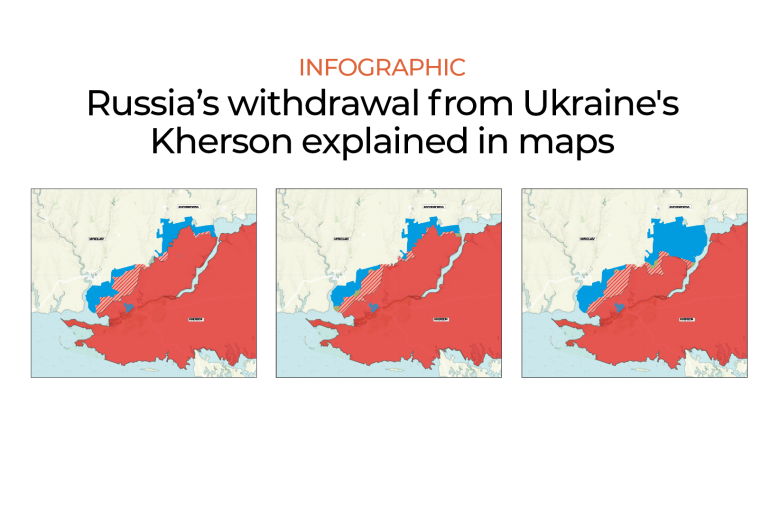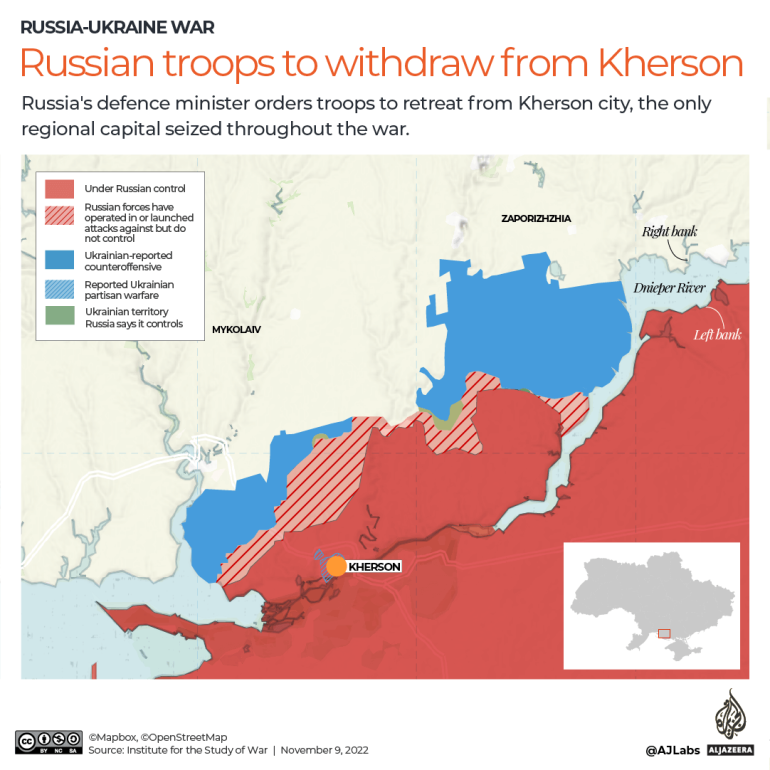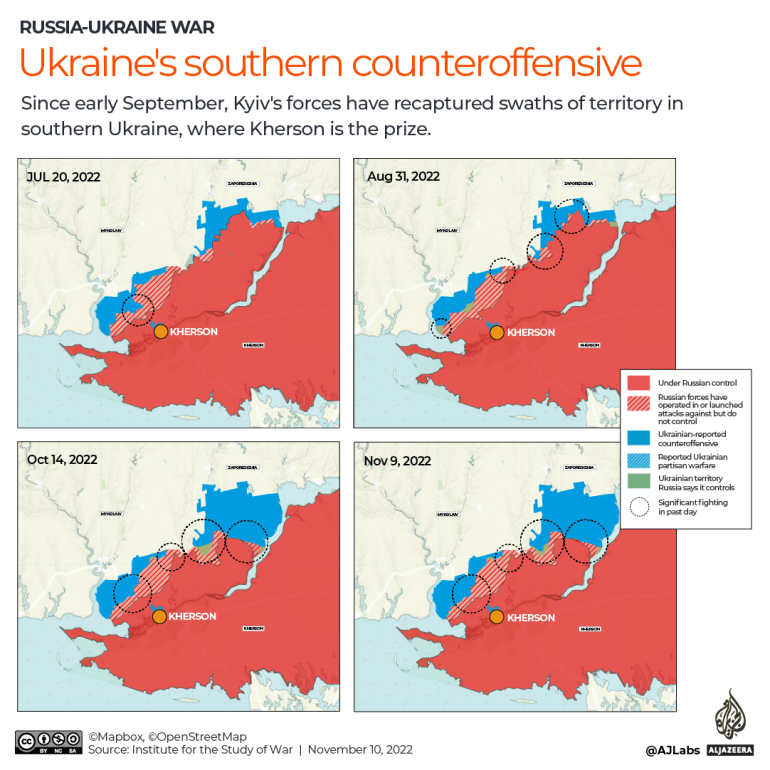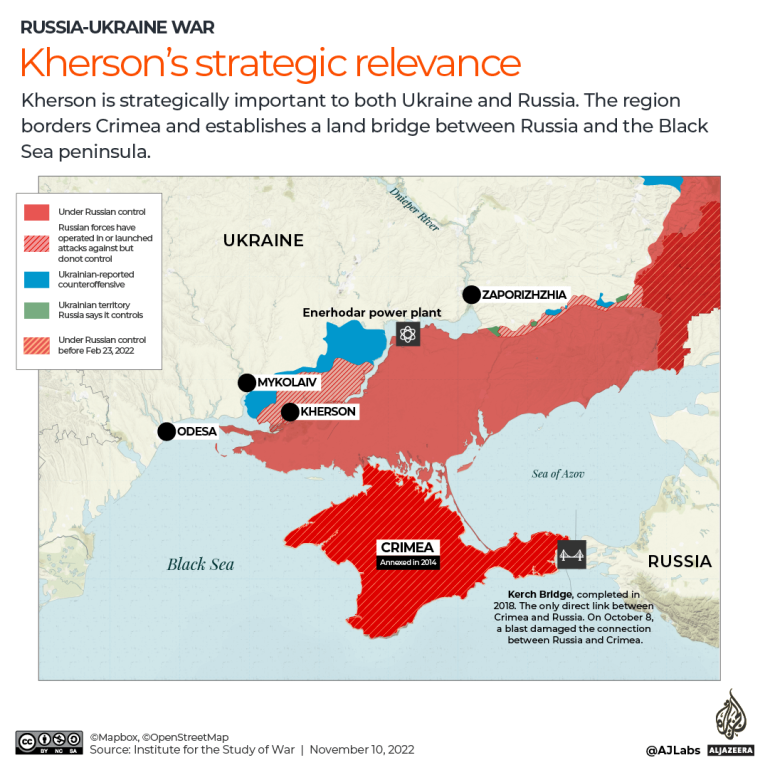Russia’s withdrawal from Ukraine’s Kherson city explained in maps
Russian troops have been ordered to withdraw from the only Ukrainian regional capital seized throughout the war.

Defence minister Sergei Shoigu on Wednesday announced Russia would pull out its troops from the southern Ukrainian city of Kherson, the first and only regional capital to be captured by Russian forces since they invaded Ukraine in late February.
The decision, Russian officials said, was taken to save the lives of Russian soldiers in the face of a Ukrainian counteroffensive and difficulties to keep supply lines to the strategic city open.
Keep reading
list of 4 itemsWorld Press Freedom Day: Gaza conflict deadliest for journalists
Mapping pro-Palestine college campus protests around the world
Satellite images reveal Israeli destruction of hospitals in Gaza
Kherson city, the capital of the eponymous province, is located on the west bank, or right side, of the Dnieper River, while much of the Kherson province is on the east of the river.
Russian forces gained control of the area in early March, with Kherson city being the only place where they had established a presence on the river’s west bank.
Ukraine responded with scepticism to Russia’s announcement, with officials saying it could be a plan to lure Ukrainian forces into a deadly trap.
“For the moment we don’t know their intentions – will they engage in fighting with us and will they try to hold the city of Kherson? They are moving very slowly,” Ukraine’s presidential adviser Oleksiy Arestovych said.

Russian control of Kherson
On February 24, Russian President Vladimir Putin announced a “special military operation” in Ukraine, with his troops invading from four fronts.
On the southern front, Russian forces moved from the Crimea Peninsula, which it annexed in 2014, towards Odesa in the west, Zaporizhzhia in the north and Mariupol in the east.
Moscow has ordered its forces to pull out from the southern Ukrainian city of Kherson.
On Wednesday, Russian officials said it was no longer feasible to continue reinforcements in the city. pic.twitter.com/QuVWSKaZPC
— AJ Labs (@ajlabs) November 10, 2022
On March 2, Russia said Kherson city was under its control. By March 15, it declared that the entire region had been taken.
Kherson is one of the four Ukrainian regions in which Russia staged “referendums” and formally “annexed” on September 30, a move that was condemned as illegal by Ukraine and its allies.

Ukraine’s counteroffensive
Russia’s annexation moves came on the back of military setbacks in the northeast, where Ukrainian forces managed to recapture large swaths of territory. Simultaneously, on the southern axis, Ukraine’s forces also escalated their counteroffensive.
By October, Ukrainian forces had retaken more than 500sq km (193sq miles) of territory and dozens of settlements in the Kherson region, according to Ukrainian President Volodymyr Zelenskyy.
Ukrainian forces were able to burst through Russia’s front lines, targeting Russian ground lines of communication, ammunition depots and military and transport assets. They also made several gains at key locations on the western bank of the Dnieper River, damaging two bridges and interfering with Russia’s efforts to sustain supplies via barge and ferry, according to the Institute for the Study of War.

The strategic relevance of Kherson
Kherson region borders Crimea and establishes a land bridge between Russia and the peninsula on the Black Sea. If Ukraine can take back control, Russia would be deprived of that land bridge and it would bring Crimea within the reach of long-range Ukrainian artillery.
The region is also significant because it has access to fresh water that supplies the arid Crimea. Ukraine had cut off freshwater supply along a canal from the Dnieper River that had supplied 85 percent of the peninsula’s needs following the annexation of Crimea. After Russia captured swaths of Kherson and Zaporizhia, it sought to unblock the canal.
Retaking Kherson city, which had a pre-war population of some 280,000 people, would mean that Ukraine will be able to get back the largest urban centre that fell to Russian hands. Meanwhile, retaking the entire region would allow it to gain control of some of the coastline along the Black Sea, enabling the exportation of food to foreign markets, which has been severely disrupted during the conflict.
